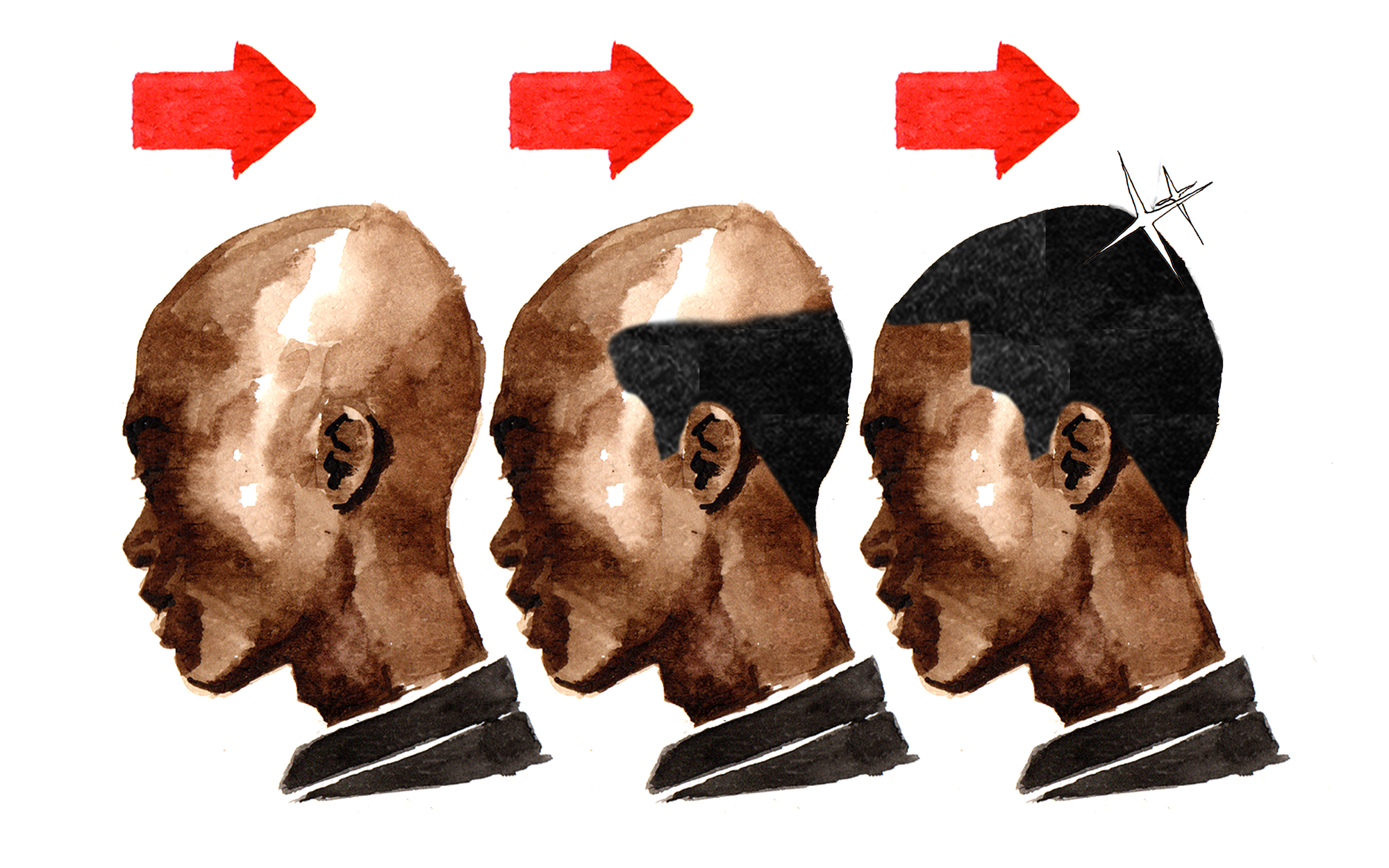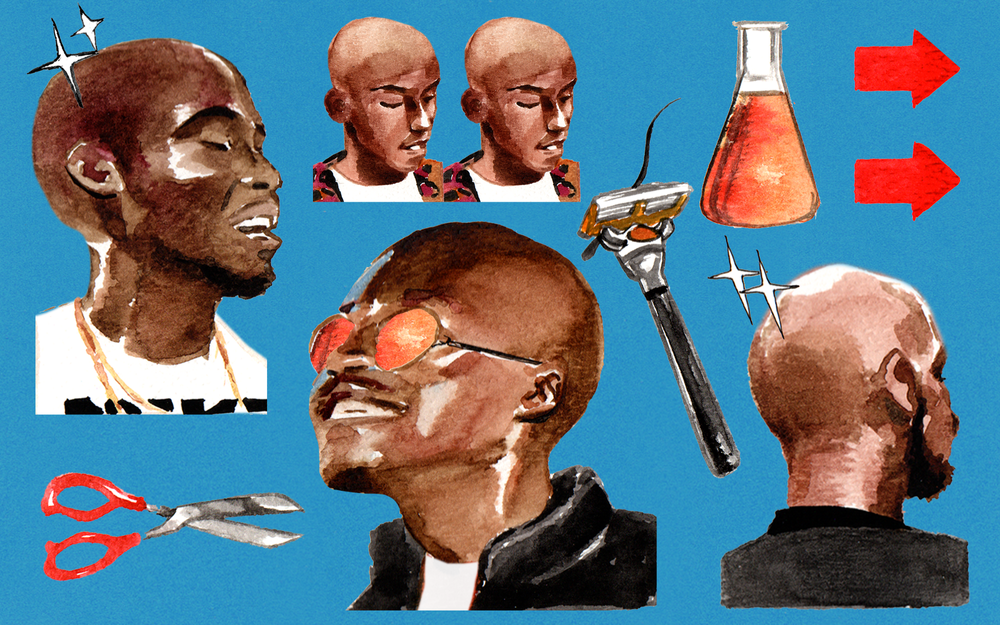There’s something singularly awful about the prospect of losing our hair. Sure, there are bigger problems in the world, but try telling us that when we look in the mirror, bemoaning the slow erosion of a once-sturdy hairline. But for an anxiety we know far too well, we know surprisingly little about the actual facts of hair loss — what causes it, if you can prevent it, how to deal with it — especially as they pertain to Black men. That’s where we come in. First, you need to know the science, then you can consider options… and even get some firsthand knowledge of how it all goes down. So don’t despair.

The Actual Science
Real-deal facts on hair loss — what we know, and what we don’t.
So there’s good news, and there’s bad news. Actually, no; there’s bad news, and then there’s worse news. By the time you’re 50, there is a 50% chance that you’ll have lost some of your hair.
And that’s just the bad news.
To make matters worse, there is no peer-reviewed scientific research specifically on Black men and hair loss. Zero. Any studies, recommendations, or stats regarding hair loss pertain either solely to White men, or a larger mix of ethnicities. Either way, it’s nearly impossible to get a sense of how prevalent hair loss is among Black men — let alone a fine-grained understanding of what causes it.
But it’s not impossible to know why that is. “The people doing these studies aren’t Black,” says Dr. William Yates, MD, a Chicago-based hair transplant surgeon who specializes in African American hair. “Our hair has a different texture and a different composition — and if there aren’t Black researchers, we won’t see our issues in these studies.”
Additionally, because male hair loss treatments are almost always handled with private payments, as opposed to covered by insurance, there’s little financial interest in studying hair loss in general.
To a degree, the universal truths about baldness still hold. First, it’s hereditary. If you’re genetically predisposed, it’s likely inevitable — though knowing where you stand isn’t as simple as the old “look at your mom’s dad” rule of thumb. Even if your parents and grandparents had a lush mane through old age, it doesn’t mean they didn’t have the gene for baldness. And if they lovingly passed that down to you, that’s that.
Similarly, the ways and places your hair can thin out persist across races. For most men, male-pattern baldness — scientifically known as androgenetic alopecia — is the most likely scenario. “That’s the George Jefferson,” says Yates. “You have hair around the back of the head and thin on top. Most men are born with two different types of hair on their head at birth. And so that pattern shows the difference in the types of hair we have, and how they thin out differently.”
While associating a thick head of hair with manliness is a common trope, the truth is actually the opposite. Baldness is largely attributed to dihydrotestosterone (DHT), a hormone derived from testosterone that’s responsible for your sex organs and their function, as well as muscle mass and a deeper voice. Although many questions remain around exactly why DHT causes hair loss, we do know that the more DHT receptors your hair follicles have, the likelier you are to lose that hair. That’s right: The more manly man testosterone you have, the likelier you are to lose your hair.
So what can be done? Yates makes it clear that you need to act quickly if you want to slow down hair loss. The first thing he recommends? Leave the juices and berries alone. The all-natural hair stuff might make your hair shiny and smell good, but it won’t help anything grow. “Our hair is very dry,” he says. “Unlike White men, we need to add moisture in, not strip it out. So add all the stuff you want — it coats the shaft and prevents breakage. But that’s not preventing or regrowing hair loss.”
Some shampoos purport to block DHT in the follicle entirely. Others include the chemical ketoconazole, which, while often included in dandruff treatments for its antifungal properties, also seems to encourage hair growth. (A good shampoo should contain 1%–2% ketoconazole as an active ingredient.) To go a step further, once-daily pills like Propecia — now available in its generic form, finasteride — and topical treatments like Rogaine (minoxidil) can fight hair loss, though not in everyone.
Chemistry being chemistry, there are side effects to consider. The ketoconazole decreases testosterone, finasteride can cause sexual dysfunction, and minoxidil can lead to cause scalp irritation among a whole host of other things.
If shampoos, pills, and creams sound too passive for your specific situation, there are experimental ways to slow or even reverse balding without going the surgery route. Remember when Kobe Bryant kept traveling to Germany for plasma injections in his degenerating knee? Now imagine that for your scalp. Platelet-rich plasma (PRP) treatments — in which blood is drawn and then separated, with the plasma injected back into the scalp — can restore the flow of nutrients to dormant follicles, reactivating them.
While there isn’t nearly enough targeted research on Black hair, Yates says there are some basic things we do understand about our hair — especially the emotional factor. “We’re supposed to be cool with losing our hair,” he says. “We’re expected to accept it. We rock baldies well and all that. But I can speak for myself: I didn’t accept it. I wanted to do something about it.”
For some, that could mean looking into surgery. For others, fiber sprays can help fill in spots. But it might just mean having patience. “The science behind hair loss is still mysterious,” says Yates. “We can just try to keep up.” — Bonsu Thompson
—

The (Honest) Truth About Hair Transplant Surgery
Yes, it can work — but it’s got limits.
J. Kevin Duplechain, M.D. knows hair. Specifically, how to make yours look better. For 25 years, the Louisiana-based cosmetic surgeon has worked magic on under-covered scalps, performing transplants and hairline restorations that would make a landscaper proud. (He works magic other ways too, but chances are you’re not in the market for a breast augmentation.) Even wizards have their limits, though; we talked to him to break down what his office can and can’t do. Yes, you can get that super-precise Jamie Foxx look — but no, you may not love the side effects. — Aliya S. King
LEVEL: First, help us clear up a few rumors. Is it true that we can determine what’s going to happen to our hair by looking at our mother’s hair loss?
Duplechain: People say look at mom’s hair, and in my office, we look at patient history focusing on brothers and fathers. But ultimately, the real culprit in all of this is dihydrotestosterone. That’s the hormone that affects follicles — it’s like they go to sleep and stop the hair from growing.
Before we go for surgery, should we try topical solutions?
Sure, there are biotin-based shampoos and certain oral vitamins that can make hair appear thicker. Think of it like fertilizer. We know shampoos and products that contain minoxidil have a 40% success rate. There are injectables that can work, too. All that can be discussed at a doctor consultation. A good doctor will give you surgical and nonsurgical options.
What is the industry standard? What do you personally prescribe? We need the plug. Literally.
Different doctors have different processes. For most, there are solutions used that are drops that go in the hair. This topical solution can take the place of the oral treatments.
And it really works?
It really works. For many, not all.
So what’s the catch?
The side effects can be… pronounced.
Uh-oh. Like what?
In some cases, impotence. Loss of interest in sex, too, or trouble having an orgasm. Not everyone has side effects. It’s a conversation and a decision each person makes for themselves.
Do you ever suggest other alternatives?
I have seen great results with cosmetic tattooing, though we rarely do that in my office. If you’re looking specifically for altering just the hairline, that’s an option — but if you need to transplant follicles, that’s a surgical procedure.
Do men come into your office and show you exactly what they want?
I get requests for Jamie Foxx’s hairline. They want that definition.
Do you think Jamie got surgery?
I’ve never treated him, so I wouldn’t feel comfortable making a call on that.
I’m guessing you’ve never seen photos of his hairline over time.
I’m looking online now. Uh… yeah, it’s safe to say there was some work done. And it looks great.
What does transplant surgery actually entail?
My office uses the NeoGraft technique. With this method, we’re removing individual hair follicles, one at a time. We focus on the “donor site” — usually the back of the head. We check each follicle for viability. Then we store them in a solution. After we get all the follicles we need, we turn the patient onto their back, and begin to implant in the targeted area, often the hairline. Other techniques would leave a large scar [Ed. — see “The [Painful] Truth About Old-School Hair Transplant Surgery” below]; this procedure does not.
How many follicles do you need to harvest?
The thicker the hair, the fewer follicles you’ll need transplanted. For Black men, you might need 800 grafts—meaning individual transplants. Northern Europeans might need 1,000 or more.
Is that because Black hair is stronger? Does it transplant better?
Not particularly. But it looks better. And because it’s thicker and curlier, it’s visually more impactful.
What are the things we should be looking for before we decide to do transplant surgery?
There are really only two. See your regular physician before and after any procedure. And besides that, find the photos that show what you want so your expectations can be managed.
What level of training should our doctor have?
NeoGraft as a technique isn’t taught in primary resident programs. Any doctor you see should have basic knowledge of male and female hair, but things like NeoGraft and cosmetic tattooing are going to be learned in auxiliary programs.
It sounds like the surgery has come a long way, but is there any other innovation you see on the horizon that’ll make these treatments even easier?
I believe we will be able to clone hair follicles in the next 10 years. We’ll be implanting not individual follicle grafts but actual cells that will regrow the hair from scratch.
That science is not available now?
I suspect it’s already there in a testing format but definitely not for consumers.
So skip the surgery and wait for the cloned hair?
By all means, you can. Should be 10 years or so.
Assuming we have that kind of time, that is.
—

The [Painful] Truth About Old-School Hair Transplant Surgery
One man took the plunge 15 years ago — and now he wants you to know what you might be getting into.
For me, it started when I was 21. I went to my barber for my usual cut — a dark Ceasar. He whispers to me, “Hey, you have a bald spot on top.”
I was in complete shock. My dad is 66 and still has a complete head of healthy hair. Literally no one in my family has lost their hair at all, especially not prematurely. My barber gave me a light Caesar but he told me it wasn’t going to last long. Within months, I realized it wasn’t going to work. My barber said he could keep pushing the line back, but I wouldn’t be happy about it.
At 22, when the hairline got ridiculous, I got a baldie. They call it coming home — when a dude gives in and shaves his head. It felt so unfair to me. I was barely old enough to drink legally. Why am I coming home? I just left!
After 10 years, I missed having a hairline. Having a dark Caesar. By this time, I’m married with children, and I’m still really young to not have hair, so I decide to do something about it. I didn’t know anything about hair transplant surgery. I did a little research and went with the best-known name at the time. That was my first mistake.
They ran me through the procedure: They would take hair from the back of my head, where I still had healthy follicles, and implant them at the top. Seemed simple enough. The only thing that concerned me was the reference photos in the office. It was all white men with longish straight hair — and a single Black dude with a huge Afro. As if that’s all a Black dude would want. The other issue was the price. It was about $15,000. And this was a decade ago. But if it meant I’d have the hairline I had as a 19-year-old, I would sacrifice it.
The procedure was horrifying. And I don’t think they really prepped me for what was about to happen. I was under local anesthesia and they made an incision on the back of my head, ear-to-ear. It was excruciating. Looking back, I don’t know why I didn’t tell them that the anesthesia wasn’t working. I could even feel the blood dripping down. That sticks out for some reason. It made it real: This is serious surgery.
The results were just okay. First, there was scabbing for like three months. Then the hair started to grow back. But it wasn’t nearly as full as I thought it would be. I actually thought I would be able to get a dark Caesar with waves; I could barely pull off a light Caesar, and waves were out of the question. I know now that my expectations were way too high, but the consultation had left me feeling like anything was possible.
And then there was the scar.
I had no idea it would be so pronounced. It’s huge. And it goes from ear to ear. Even after my hair grew back, people would see me and say, “Oh no, how did you get that scar?” It still hasn’t completely gone away — 15 years later.
I also didn’t know that if you didn’t like the results in a few years, you’d have to do the whole surgery again. After three years. I wasn’t thrilled, so I found a different surgeon and did it again. This surgeon was double the price of the first, and the surgery was even more painful. The scarring wasn’t as bad, but it was still terrible. I could feel the grafts being implanted and I literally wanted to faint.
Then, after all that, they still expected me to keep up with different hair care products like Propecia, which can have all kinds of side effects. Plus, after going through the scabbing and scarring all over again, when my hair grew back, it looked exactly the same as after the first surgery!
What I realize now is that for Black men, we have to be more specific and our hair needs are much different. Straight hair can grow and cover the scar. My regular haircut would never cover the scar. You need to talk to your doctor the way you would talk to your barber. If you tell the doctor you want to be able to get a dark Caesar and waves and he doesn’t know what you’re talking about? That’s not the doctor for you.
Basically, I took a huge L for men who are thinking about having any kind of hair loss surgery. I went through it so you won’t have to. After many years and several surgeries, I’m done. Soon after my second surgery, I made the decision to “come home” once again. And I’m not leaving.
—As told to Aliya S. King

